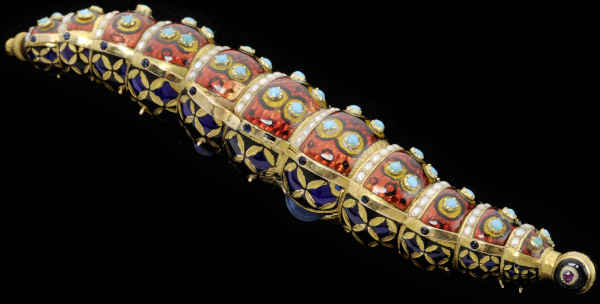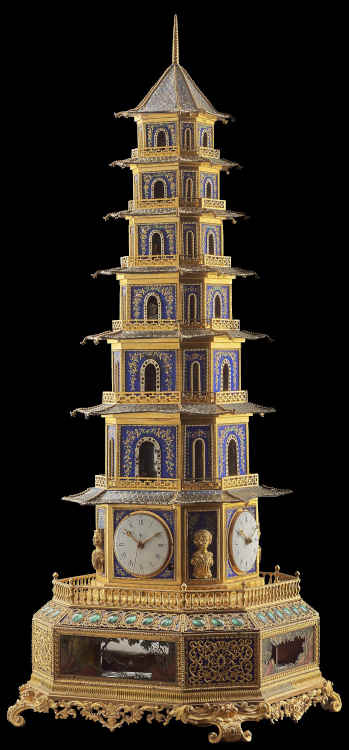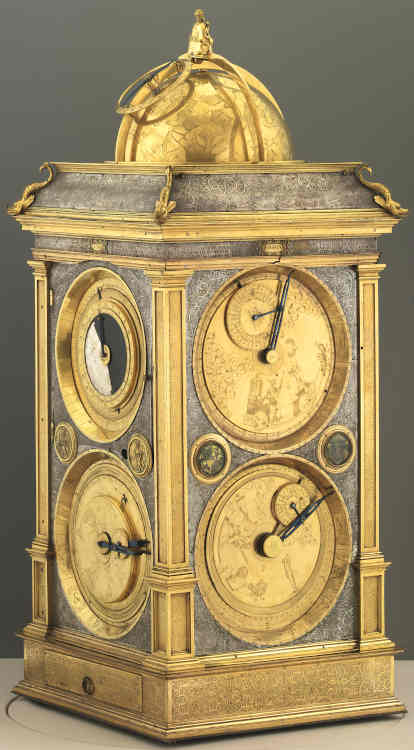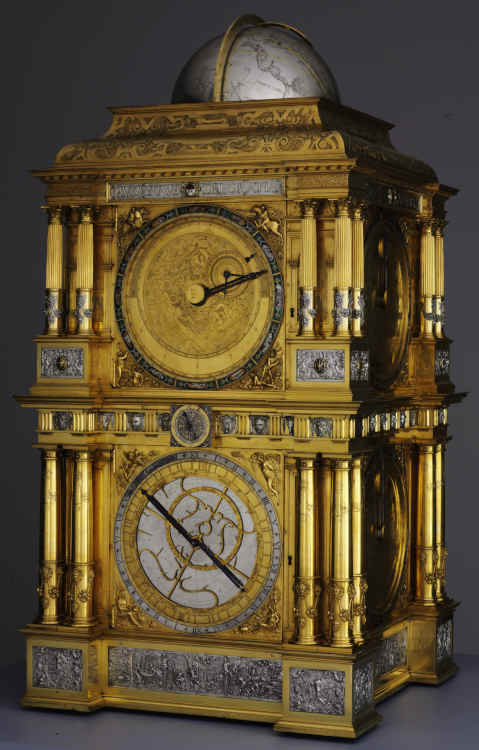Communications of the ACM
The World's Most Magnificent Historical Automatons

Automatons are ubiquitous. However, many look rather ugly, in contrast to numerous great historical machines. Clockmakers and goldsmiths often made such artistic objects. Some of the magnificent works have survived in museums. A small selection follows, see also Superb Historical Robots | blog@CACM | Communications of the ACM
A particularly beautiful animal automaton is the following silk caterpillar (see Fig. 1).

Fig. 1: Silk caterpillar.
The animal automaton is attributed to Henri Maillardet or Piguet & Capt (Geneva or London, beginning of the 19th century). It consists of gold rings, semi-pearls, translucent red enamel, gemstones, and emerald stones.
Credit: Musée d'horlogerie du Locle, Château des Monts, Le Locle NE. Picture: Renaud Sterchi.
The Tower and Ship Automatons and Chariots were popular. For automaton figures, there are no limits to creativity. In several museums, there are numerous precious, still-functional automatons, many of which incorporate a musical mechanism (see Figs. 2–5).
Fig. 2: Bell tower automaton (around 1580).
This fire-gilded automaton, attributed to Hans Schlottheim, is made of bronze. The painted figures of glass, metal, and wood are partly clothed.
Credit: Kunsthistorisches Museum Wien/KHM-Museumsverband.
Fig. 3: Automaton in the form of a ship (1585).
This gold-plated table automaton of Hans Chlottheim is made of silver, a copper alloy, and cold glaze, as well as oil paintings. The drive mechanism rolls over the table and plays music. The cannons can be loaded with black powder.
Credit: Kunsthistorisches Museum Wien/KHM-Museumsverband.

Fig. 4: Automaton in the form of a triumphal chariot (about 1760–1770).
Four horses draw the carriage. The British author is unknown. A spring-like device over the right front wheel drives this wheel and two interconnected shafts under the horses. The carriage can be controlled to the left and right.
Credit: Metropolitan Museum of Art, New York.

Fig. 5: Pagoda automaton clock.
This gilded bronze tower clock, built in 1780 in London, is probably the work of James Cox. The musical clock has a striking mechanism, together with dancing signs of the zodiac. Rolling glass rods convey the impression of flowing water. An East Asian pagoda is a Buddhist multistory tower-like temple.
Credit: Uhrenmuseum Beyer, Zurich. Picture: Thierry Bösiger, Winterthur.
Planetary clocks were extremely sophisticated (see Figs. 6-7).

Fig. 6: The Wilhelmsuhr (1560–1561).
With the aid of a complex clockwork, the planetary (orbit) clock of the clockmaker Eberhard Baldewein simulates all celestial movements in the sky. The four lateral walls each have two planetary discs with pointers. Baldewein's astronomical clock simulates the motions of the moon according to the classical Ptolemaean (geocentric) orbital theory.
Credit: Museumslandschaft Hessen Kassel, Astronomisch-physikalisches Kabinett.

Fig. 7: Planetary clock.
The astronomical clock from 1563–1568 is a work of Eberhard Baldewein, Hans Bucher, and Hermann Diepel. On the upper hand, the disc for Mars is depicted. The planet requires 1.881 years on the average to revolve about the Earth. In the small display at the center, a quarter-hour and weekday dial can be seen. The lower display constitutes an astrolabe. A celestial globe rotates on the clock in sidereal time.
Credit: Mathematisch-physikalischer Salon, Dresden.
Sources
You will find detailed descriptions of these and many other historical automatons and robots in:
Bruderer, Herbert: Meilensteine der Rechentechnik, De Gruyter Oldenbourg, Berlin/Boston, 3. Auflage 2020, Band 1, 970 Seiten, 577 Abbildungen, 114 Tabellen, https://www.degruyter.com/view/title/567028?rskey=xoRERF&result=7
Bruderer, Herbert: Meilensteine der Rechentechnik, De Gruyter Oldenbourg, Berlin/Boston, 3. Auflage 2020, Band 2, 1055 Seiten, 138 Abbildungen, 37 Tabellen, https://www.degruyter.com/view/title/567221?rskey=A8Y4Gb&result=4
Bruderer, Herbert: Milestones in Analog and Digital Computing, Springer Nature Switzerland AG, Cham, 3rd edition 2020, 2 volumes, 2113 pages, 715 illustrations, 151 tables, https://www.springer.com/de/book/9783030409739
Further Reading
Bailly, Christian: Automaten. Das goldene Zeitalter 1848–1914, Hirmer Verlag München 1988, 359 pages
Beyer, Annette: Faszinierende Welt der Automaten. Uhren, Puppen, Spielereien, Verlag D. W. Callwey, Munich 1983, 255 pages
Chapuis, Alfred: Automates. Machines automatiques et machinisme, SA des publications techniques, Geneva 1928, 114 pages
Chapuis, Alfred; Droz, Edmond: Automata. A historical and technological study, Editions du Griffon, Neuchâtel 1958, 413 pages
Chapuis, Alfred; Droz, Edmond: Les automates. Figures artificielles d'hommes et d'animaux. Histoire et technique, Editions du Griffon, Neuchâtel 1949, 433 pages
Chapuis, Alfred; Gélis, Edouard: Le monde des automates. Etude historique et technique, Editions Slatkine, Geneva 1984, volume 1, xvi, 350, ii pages (reprint from 1928)
Chapuis, Alfred; Gélis, Edouard: Le monde des automates. Etude historique et technique, Editions Slatkine, Geneva 1984, volume 2, v, 356, iii pages (reprint from 1928)
Heckmann, Herbert: Die andere Schöpfung. Geschichte der frühen Automaten in Wirklichkeit und Dichtung, Umschau Verlag Breidenstein GmbH, Frankfurt am Main 1982, 288 pages
Héron d'Alexandrie: Les mécaniques ou l'élévateur des corps lourds, Société d'édition Les belles lettres, Paris 1988, 305 pages (in French), iii, 115 pages (in Arabic) (reprint from 1894)
Junier, Caroline; Künzi, Claude-Alain (eds.): Automates et merveilles. Les Jaquet-Droz et Leschot, Editions Alphil, Neuchâtel 2012, 80 pages
Maingot, Éliane: Les automates, Librairie Hachette, Paris 1959, 96 pages
Rausch, Manuela: Heron von Alexandria. Die Automatentheater und die Erfindung der ersten antiken Programmierung, Diplomica Verlag GmbH, Hamburg 2012, 78 pages
Schmidt, Wilhelm (ed.): Herons von Alexandria Druckwerke und Automatentheater, Druck und Verlag von B. G. Teubner, Leipzig 1899, lxxii, 514, 182 pages (reprint in 1976)
Acknowledgements
Part of this translation was done by Dr. John McMinn, who translated my book "Meilensteine der Rechentechnik" into English.
Herbert Bruderer is a retired lecturer in didactics of computer science at ETH Zurich. More recently, he has been an historian of technology. [email protected], herbert.bruderer@bluewin.
No entries found